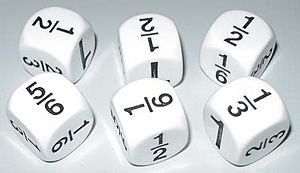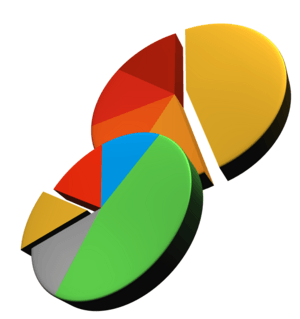Fractions facts for kids
A fraction is a special kind of number that helps us understand parts of a whole. Imagine you have a pizza, and you cut it into equal slices. A fraction tells you how many of those slices you have, compared to the total number of slices.
When we write fractions, we usually see one number on top of another, separated by a line. For example,  , 1⁄4 and 1/4 all show the same fraction. This fraction means "one quarter."
, 1⁄4 and 1/4 all show the same fraction. This fraction means "one quarter."
The number on top is called the numerator. It tells you how many parts you have. The number on the bottom is called the denominator. It tells you the total number of equal parts that make up the whole.
For example, in the fraction  :
:
- The 1 is the numerator.
- The 4 is the denominator.
This means you have 1 part out of a total of 4 equal parts.
Contents
What Fractions Show Us
Fractions are super useful in everyday life! They help us describe situations where things are divided into equal pieces.
- Imagine a room where
 of the people are girls. This means for every 4 people in the room, 1 of them is a girl.
of the people are girls. This means for every 4 people in the room, 1 of them is a girl. - Think about a cake cut into 4 equal slices. Each slice is
 of the whole cake. If you eat 2 slices, you've eaten
of the whole cake. If you eat 2 slices, you've eaten  of the cake. This is the same as eating
of the cake. This is the same as eating  (one-half) of the cake!
(one-half) of the cake!
Fractions in Math
In mathematics, a fraction is a way to show how one number is divided by another. When both numbers are whole numbers, we call this a rational number. For example,  is a rational number.
is a rational number.
A fraction like  simply means "one divided by two." If you do that division, you get 0.5 as a decimal.
simply means "one divided by two." If you do that division, you get 0.5 as a decimal.
Multiplying Fractions
Multiplying fractions is easier than you might think! To multiply two fractions, you just multiply the numerators (the top numbers) together, and then multiply the denominators (the bottom numbers) together.
For example: 2⁄4 x 3⁄4
1. Multiply the numerators: 2 x 3 = 6 2. Multiply the denominators: 4 x 4 = 16
So, 2⁄4 x 3⁄4 = 6⁄16.
You can often make the answer simpler by dividing both the numerator and the denominator by a common number. In this case, both 6 and 16 can be divided by 2. 6 ÷ 2 = 3 16 ÷ 2 = 8
So, 6⁄16 simplifies to 3⁄8.
Dividing Fractions
To divide one fraction by another, you use a special trick! You multiply the first fraction by the reciprocal of the second fraction. The reciprocal of a fraction is just that fraction flipped upside down.
For example, to find  divided by
divided by  : 1. Find the reciprocal of the second fraction (
: 1. Find the reciprocal of the second fraction ( ). The reciprocal of
). The reciprocal of  is
is  (or just 2). 2. Now, multiply the first fraction by this reciprocal:
(or just 2). 2. Now, multiply the first fraction by this reciprocal:  x 2 = 1.
x 2 = 1.
So,  divided by
divided by  equals 1.
equals 1.
Related pages
Images for kids
See also
 In Spanish: Fracción para niños
In Spanish: Fracción para niños






